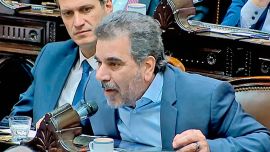Argentina’s poverty rate rose to 40.1 percent in the first half of 2023, with an estimated 18.6 million people in total now considered poor.
Of those, 9.3 percent of the economically active population was considered to be living in extreme poverty by the end of June, with destitution increasing across all regions nationwide.
The stark figures, which were published by the INDEC national statistics bureau on Wednesday, were accompanied by a warning from specialists that poverty has likely worsened even further in the last month as a result of the August 14 devaluation of the peso against the dollar in the wake of tumultuous PASO primaries.
Publication of the new rate comes just a few days before the first presidential debate of the election campaign and less than a month before voters go to the polls. Economy Minister Sergio Massa is running as the candidate for the ruling coalition and is sure to face criticism from his main rivals, opposition leader Patricia Bullrich and libertarian frontrunner Javier Milei, over the number of Argentines who have slipped below the poverty line.
According to INDEC’s biannual Permanent Household Survey (EPH), which is based on 31 major urban conglomerates, 40.1 percent of the population was considered to be living in poverty in the first half of the year – a total of 11.8 million citizens. In addition, 9.3 percent were considered to be living in extreme poverty – a total of 2.7 million. Projected out to the whole population, that equates to 18.6 million people being considered as poor, with 4.3 million considered destitute.
Drilling down into the report, INDEC warns that 56.2 percent of people aged 0 to 14 are now considered poor. The highest numbers of poverty-stricken are found in the northeast of the country (42 percent) and Greater Buenos Aires (41.4 percent).
The percentage of households falling below the poverty line was 29.6 percent, while 6.8 percent fell below the extreme poverty line.
The poverty rate stood at 39.2 percent of the economically active population in the second half of last year, 0.9 points difference with the latest figure and up from 37.3 percent in the first half of 2022. Extreme poverty affected 8.1 percent at the same time and has risen 1.2 points in the latest INDEC report.
The new figure is the highest recorded by INDEC since the peak of 42 percent registered in 2020 during the peak of the coronavirus pandemic.
Reacting to the news, Agustín Salvia, the director of the influential Observatorio de la Deuda Social of the UCA Catholic University, described the figures as “outdated” and warned that the true rate today is closer to 43 percent.
Former head of state “Mauricio Macri left a poverty rate of 38 percent and [President] Alberto Fernández will probably leave a rate of 45 percent and with more than 50 percent of the population benefiting from some system of economic assistance that seeks to alleviate the problem,” Salvia said in an interview with Radio Perfil.
“The figure given, which is already outdated because today we would be reaching 44 percent, hides two realities. On the one hand, 30 percent of Argentina is structurally and chronically poor, and even if inflation falls, it will not be easy to reduce this poverty,” he concluded.
"The lack of health, education and security means that having a decent life in Argentina is very difficult, and it is necessary to have a lot of economic resources to access goods and services that imply progress for society," Salvia emphasised.
Estimates on track
Most private estimates had forecast a rate of more than 40 percent, driven in large part but runaway inflation that hit record levels in August and falling purchasing power.
Inflation, currently running at 124 percent per annum, totalled 50.7 percent in the first half of 2023 and has continued to rise. In the first eight months of the year, consumer prices have increased 80.2 percent. In August, INDEC reported a rise of 12.4 percent – the highest monthly figure in 32 years.
According to a recent report by the UCA university, the poverty rate reached 38.9 percent of the population in September, a rate similar to that observed in 2006, that is, 17 years ago; and this would rise to 50 per cent without the Universal Child Allowance (AUH) and other social plans, the study indicated.
Children and adolescents are the most affected by this situation: in this case the rate reaches 61.6 percent up to the age of 17, according to the UCA unit.
"Prices rise and families' incomes cannot recover; over time they are always lower and with very significant losses from one month to the next," said Eduardo Donza, a researcher at the UCA Observatory.
Donza said that, in addition to inflation, the employment status of many Argentines is "precariousness," forcing many to look for additional sources of income to make it to the end of the month.
"There is a situation of loss of purchasing power for all groups of the population," agreed Leopoldo Tornarolli, a researcher at the Centre for Distributive, Labour and Social Studies at the National University of La Plata.
According to the expert, the loss is trending upwards and poverty by the end of the year could exceed the 42 percent recorded at "the worst moment of the pandemic" at the end of 2020.
"There are households with lower real incomes across all [socio-economi] strata and that means that some who were middle class become vulnerable and some who were vulnerable become poor," he explained.
When President Alberto Fernández assumed office in December 2019, poverty stood at 34.7 percent. The number of those considered poor, however, soared during the Covid-19 pandemic and the accompanying collapse in economic activity.
– TIMES/NA/PERFIL























Comments